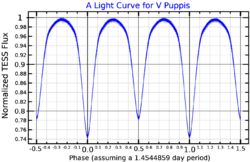Astronomy:V Puppis
| Observation data Equinox J2000.0]] (ICRS) | |
|---|---|
| Constellation | Puppis |
| Right ascension | 07h 58m 14.43920s[1] |
| Declination | −49° 14′ 41.6803″[1] |
| Apparent magnitude (V) | 4.41[2] (5.10 + 5.59)[3] |
| Characteristics | |
| Spectral type | B1Vp + B3IV:[4] |
| U−B color index | −0.96[2] |
| B−V color index | −0.17[2] |
| Variable type | β Lyr[5] |
| Astrometry | |
| Radial velocity (Rv) | +19.40[6] km/s |
| Proper motion (μ) | RA: -5.34[1] mas/yr Dec.: +7.12[1] mas/yr |
| Parallax (π) | 3.40 ± 0.29[1] mas |
| Distance | 960 ± 80 ly (290 ± 30 pc) |
| Absolute magnitude (MV) | −3.56[7] |
| Orbit[3] | |
| Primary | V Pup Aa |
| Companion | V Pup Ab |
| Period (P) | 1.4544859 d |
| Semi-major axis (a) | 14.96±0.2 R☉ |
| Details | |
| V Pup Aa | |
| Mass | 14.0[3] M☉ |
| Radius | 5.48[3] R☉ |
| Luminosity | 12,600[3] L☉ |
| Temperature | 26,000[3] K |
| Rotational velocity (v sin i) | 275.0[8] km/s |
| V Pup Ab | |
| Mass | 7.3[3] M☉ |
| Radius | 4.59[3] R☉ |
| Luminosity | 6,500[3] L☉ |
| Temperature | 24,000[3] K |
| Age | 5[3] Myr |
| Other designations | |
| Database references | |
| SIMBAD | data |
V Puppis (V Pup) is a star system in the constellation Puppis. Its apparent magnitude is 4.41.[2] There is a binary star system at the center with a B1 dwarf orbiting a B3 subgiant star.[4] They have an orbital period of 1.45 days and a distance of only 15 solar radii apart.[3] However, the system moves back and forth, indicating that there is a massive object orbiting them with a period around 5.47 years. Based on the mass of the object, its lack of a visible spectrum, and circumstellar matter in the system with many heavy elements (as would be produced by a past supernova in the system), it is probably a black hole.[9][10] However, a follow-up study could not confirm this object, but found signs that there may be a third object which is fainter than the other components.[11]

In addition to the main system, more distant components have been reported: B, at magnitude 11.5 and separation 6.2", C, at magnitude 13.2 and separation 18.9", D, at magnitude 9.88 and separation 39", and E, at magnitude 13 and separation from D of 10.4".[13]
References
- ↑ 1.0 1.1 1.2 1.3 1.4 Van Leeuwen, F. (2007). "Validation of the new Hipparcos reduction". Astronomy and Astrophysics 474 (2): 653–664. doi:10.1051/0004-6361:20078357. Bibcode: 2007A&A...474..653V. Vizier catalog entry
- ↑ 2.0 2.1 2.2 2.3 Ducati, J. R. (2002). "VizieR Online Data Catalog: Catalogue of Stellar Photometry in Johnson's 11-color system". CDS/ADC Collection of Electronic Catalogues 2237. Bibcode: 2002yCat.2237....0D.
- ↑ 3.00 3.01 3.02 3.03 3.04 3.05 3.06 3.07 3.08 3.09 3.10 3.11 Budding, E.; Love, T.; Blackford, M. G.; Banks, T.; Rhodes, M. J. (2021). "Absolute Parameters of Young Stars: V Puppis". Monthly Notices of the Royal Astronomical Society 502 (4): 6032–6043. doi:10.1093/mnras/stab381.
- ↑ 4.0 4.1 Hoffleit, D.; Warren, W. H. (1995). "VizieR Online Data Catalog: Bright Star Catalogue, 5th Revised Ed. (Hoffleit+, 1991)". VizieR On-line Data Catalog: V/50. Originally Published in: 1964BS....C......0H 5050. Bibcode: 1995yCat.5050....0H.
- ↑ Samus, N. N. et al. (2009). "VizieR Online Data Catalog: General Catalogue of Variable Stars (Samus+ 2007-2013)". VizieR On-line Data Catalog: B/GCVS. Originally Published in: 2009yCat....102025S 1. Bibcode: 2009yCat....102025S.
- ↑ Pourbaix, D.; Tokovinin, A. A.; Batten, A. H.; Fekel, F. C.; Hartkopf, W. I.; Levato, H.; Morrell, N. I.; Torres, G. et al. (2004). "SB9: The ninth catalogue of spectroscopic binary orbits". Astronomy and Astrophysics 424 (2): 727–732. doi:10.1051/0004-6361:20041213. Bibcode: 2004A&A...424..727P.
- ↑ Anderson, E.; Francis, Ch. (2012). "XHIP: An extended hipparcos compilation". Astronomy Letters 38 (5): 331. doi:10.1134/S1063773712050015. Bibcode: 2012AstL...38..331A. Vizier catalog entry
- ↑ Glebocki, R.; Gnacinski, P. (2005). "VizieR Online Data Catalog: Catalog of Stellar Rotational Velocities (Glebocki+ 2005)". VizieR On-line Data Catalog: III/244. Originally Published in: 2005csss...13..571G; 2005yCat.3244....0G 3244. Bibcode: 2005yCat.3244....0G. Vizier catalog entry
- ↑ Kaler, Jim (2 Jan 2009). "V Pup". Stars. http://stars.astro.illinois.edu/sow/vpup.html.
- ↑ Qian, S.‐B.; Liao, W.‐P.; Fernández Lajús, E. (2008). "Evidence of a Massive Black Hole Companion in the Massive Eclipsing Binary V Puppis". The Astrophysical Journal 687 (1): 466–470. doi:10.1086/591515. Bibcode: 2008ApJ...687..466Q.
- ↑ Budding, E; Love, T; Blackford, M G; Banks, T; Rhodes, M J (9 March 2021). "Absolute parameters of young stars: V puppis". Monthly Notices of the Royal Astronomical Society 502 (4): 6032–6043. doi:10.1093/mnras/stab381.
- ↑ "MAST: Barbara A. Mikulski Archive for Space Telescopes". Space Telescope Science Institute. https://mast.stsci.edu/portal/Mashup/Clients/Mast/Portal.html.
- ↑ Mason, Brian D.; Wycoff, Gary L.; Hartkopf, William I.; Douglass, Geoffrey G.; Worley, Charles E. (2001). "The 2001 US Naval Observatory Double Star CD-ROM. I. The Washington Double Star Catalog". The Astronomical Journal 122 (6): 3466. doi:10.1086/323920. Bibcode: 2001AJ....122.3466M. Vizier catalog entry
Coordinates: ![]() 07h 58m 14.43920s, −49° 14′ 41.6803″
07h 58m 14.43920s, −49° 14′ 41.6803″
 |


